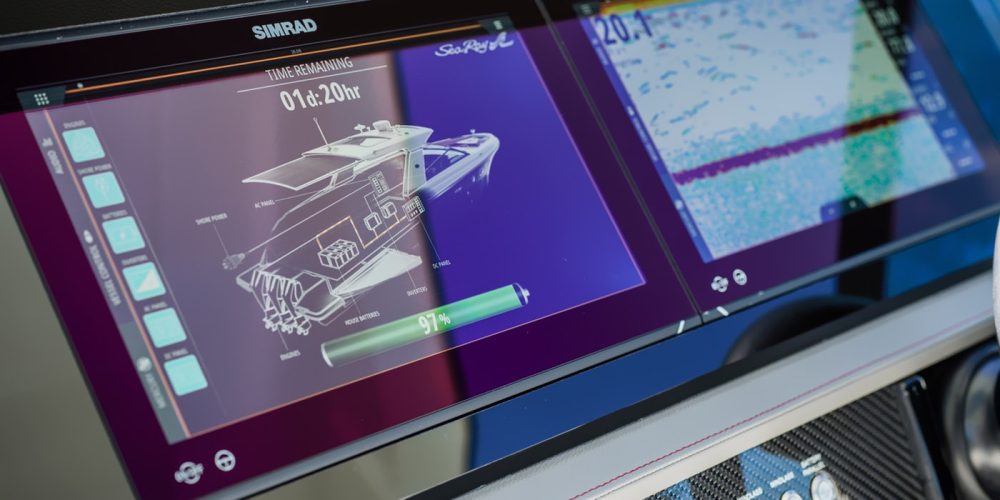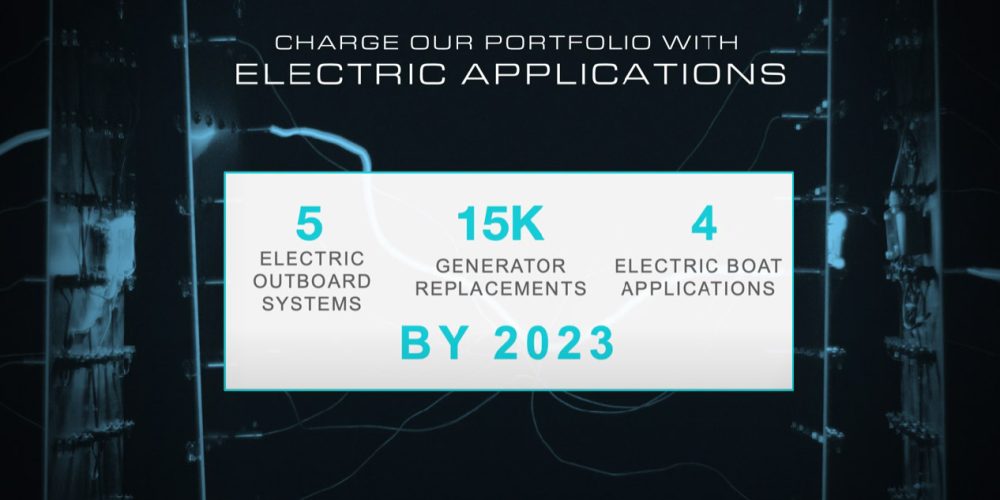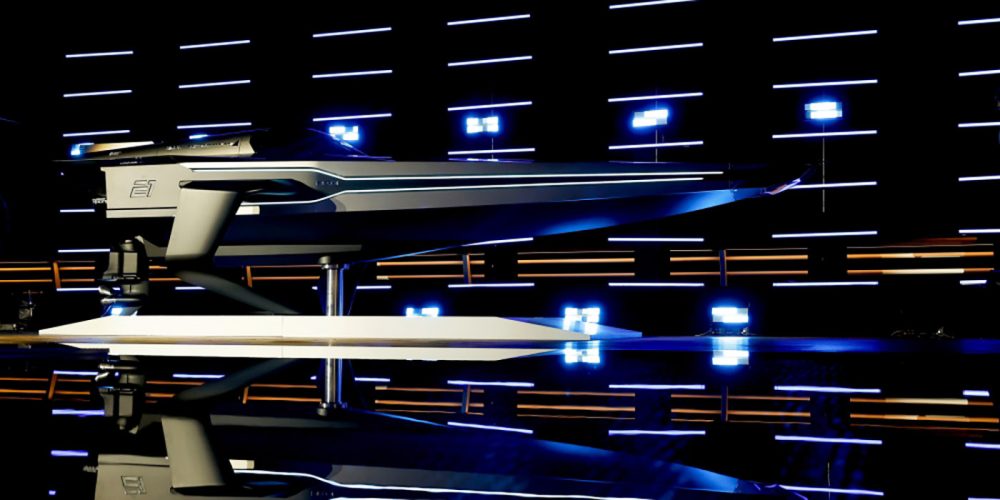Electric boats have been around for a long time, mainly in applications where the expectations for range and speed are lower than large powerboats. Now, companies like Taiga Motors and Nautique are leveraging electric motors’ low-end torque to enhance the water powersport experience – but bigger boats carry bigger expectations. Brunswick’s ACES strategy, revealed this week at CES 2022 in Las Vegas, aims to meet those expectations head-on.
The two biggest challenges facing boatbuilders in terms of electrified propulsion are best visualized with a comparison to road vehicles. Simply, it takes more effort to move through a thicker fluid (water) than a thinner one (air), and more effort equals more energy. That’s the first challenge. The second involves braking. A car, bike, or whatever the Arcimoto is can use its braking system to recover some of the energy that went into getting it going (kinetic energy) then convert that kinetic energy into electrical energy to recharge the battery. It works great, but (alas!) boats don’t have brakes.
Brunswick is calling its approach to future boatbuilding ACES (which stands for Autonomy, Connectivity, Electrification, and Shared access), and the company believes its more holistic approach to boating will advance electrification by improving efficiency and the boating experience.
And, don’t worry, we’re only going to focus on the A and E parts.
Autonomy
First up is autonomy, which isn’t just about autonomous navigation – although that’s certainly a part of it. It’s also about autonomous parking. Brunswick’s “assisted docking” system uses “advanced machine vision technology to sense and identify potential obstacles in the vessel’s path” and provides feedback to the boat’s JPO system (Joystick Piloting for Outboards) to autonomously respond to marina conditions and ensure a smooth docking process.
If you’ve never tried to dock a boat or binge-watched Below Deck on Bravo (which, you totally should), you’re going to have to trust me on this one: docking the boat is by far the most stressful part.
Let’s get to electrification.
The next step is electrification, not just of the propulsion system but of all the systems that currently rely on internal combustion in conventional boats. That’s where the Brunswick Fathom e-Power system comes into play.

First shown as a concept at CES in 2020, this “first of its kind” electrification is finally ready for prime time. The Fathom e-Power system replaces the boat’s on-board, electrical generator with a high-capacity lithium-ion battery pack from Mastervolt. The Fathom’s intelligent and intuitive systems maximize the electricity stored there to run all of the boat’s accessory systems (which includes the autonomous AI).
Replacing the generator with a battery pack may sound like greenwashing, but it’s a massive improvement in terms of carbon emissions. How massive? According to one study by the California Air Resource Board (CARB), “operating a new, average portable gas generator (~3.5 hp) at an average load of 1.8 kW for 1 hour emits as much smog-forming pollution as driving an average passenger vehicle for about 150 miles.” The gas generator on something like a Sea Ray Sundancer 370, meanwhile, is rated at just over 10 hp (7.5 kW).
That’s a huge improvement, and Brunswick will be replacing some 15,000 gas generators with its new battery pack system by 2023. Doing some quick math, the switch is essentially removing the equivalent of 15 * 15,000, or 2,250,000 miles, worth of air pollution from an internal combustion car every hour that those generators would have been running!
Oh – and Brunswick be launching five fully electric propulsion systems this year, too. I probably should have led with that.

Don’t get too excited about those five electric outboard systems, though – you’ll only be able to choose from four. That’s because the fifth one is bring reserved for Brunswick’s Mercury Marine RaceBird, a futuristic, ultra-fast electric racer that’s set to compete in the inaugural season of the E1 electric powerboat racing series that kicks off in 2023.
You can see the RaceBird for yourself below. And, if you squint hard enough, you might even be able to see Bruce Wayne in the cockpit.

Electrek’s Take:
In the same way that many EV enthusiasts overlook the commercial van business in favor of fast, sexy cars like the Tesla Model S or Porsche Taycan, it’s easy to miss a lot of low-hanging fruit in the world of recreational boating carbon emission reduction. That’s especially true when it comes to things like generators and outboard motors that put out harmful emissions at a much, much higher rate than passenger cars.
How much higher? The guys at Pure Watercraft did some of the math – Per gallon of gas burned, federal regulations allow a car to emit up to 104.6 grams of CO, but an outboard motor can emit 13.831 kg (132 times more). Additionally, per gallon of gas, a car is allowed to emit 3.98 grams of NOx + NMOG whereas an outboard motor can emit 655 grams of HC + NOx (165 times more).
This isn’t chump change, in other words. If the math is right, that means the electrification of the marine industry – even just from a recreational standpoint – could make the same impact as switching thousands of ICE drivers to EVs.
Sources | Images: Brunswick, CARB, Nautique, Pure.
Subscribe to Electrek on YouTube for exclusive videos and subscribe to the podcast.

I’m bookmarking this for future reference. Truly a helpful article.
lasuna usa – buy cheap generic himcolin buy himcolin without a prescription
besivance drug – buy besifloxacin cheap purchase sildamax for sale
gabapentin 800mg over the counter – neurontin 100mg us buy sulfasalazine 500mg sale
buy benemid medication – brand probalan how to get carbamazepine without a prescription
brand celecoxib 100mg – buy celecoxib pills for sale how to buy indomethacin
cost voltaren 100mg – buy aspirin 75mg generic buy aspirin 75 mg generic
order pyridostigmine 60 mg without prescription – imuran canada buy azathioprine 25mg pills
voveran without prescription – buy isosorbide buy nimotop for sale
baclofen 25mg for sale – brand baclofen 10mg piroxicam medication
buy periactin medication – order tizanidine 2mg pills tizanidine 2mg over the counter
purchase trihexyphenidyl generic – voltaren gel online purchase purchase diclofenac gel cheap
cefdinir 300mg without prescription – order cleocin online cheap
buy isotretinoin 10mg without prescription – buy generic avlosulfon for sale deltasone 40mg us
prednisone 10mg brand – prednisolone online buy order zovirax online cheap
acticin sale – buy benzoyl peroxide for sale buy generic tretinoin gel
betamethasone oral – order betnovate 20 gm generic benoquin online
generic metronidazole 200mg – buy metronidazole 200mg generic cenforce brand
augmentin tablet – clavulanate pill purchase levothroid
clindamycin over the counter – buy cleocin 300mg generic order indocin 50mg without prescription
losartan 50mg oral – cephalexin 250mg for sale buy keflex online
eurax oral – order mupirocin generic generic aczone
buy zyban 150 mg pill – cheap ayurslim pills shuddha guggulu sale
order generic modafinil 100mg – provigil 100mg without prescription buy melatonin 3mg sale
prometrium 100mg uk – buy ponstel no prescription clomiphene buy online
buy cheap generic xeloda – order generic naproxen 250mg buy danocrine 100 mg for sale
buy norethindrone 5 mg – yasmin generic order yasmin online
cheap fosamax – order alendronate 70mg pill medroxyprogesterone order online
buy generic yasmin – buy ginette 35 pills buy cheap generic anastrozole
г‚·гѓ«гѓ‡гѓЉгѓ•г‚Јгѓ« её‚иІ© гЃЉгЃ™гЃ™г‚Ѓ – г‚їгѓЂгѓ©гѓ•г‚Јгѓ«гЃ®йЈІгЃїж–№гЃЁеЉ№жћњ г‚їгѓЂгѓ©гѓ•г‚Јгѓ« е‰ЇдЅњз”Ё
гѓ—гѓ¬гѓ‰гѓ‹гѓійЊ 20 mg еј·гЃ• – г‚ўг‚ュテイン通販 安全 イソトレチノインは薬局で買える?
order crixivan for sale – cost confido voltaren gel online order
valif pills inside – order secnidazole online sinemet order
purchase modafinil – purchase lamivudine generic buy epivir generic
ivermectin 6 mg for people – candesartan online carbamazepine 400mg tablet
phenergan for sale online – buy ciplox 500mg generic buy lincocin 500mg without prescription
cost isotretinoin – purchase absorica without prescription buy linezolid 600 mg pills
buy amoxicillin generic – combivent 100mcg without prescription buy combivent without a prescription